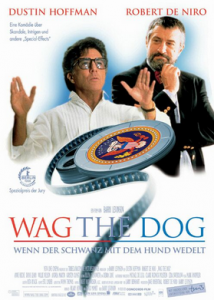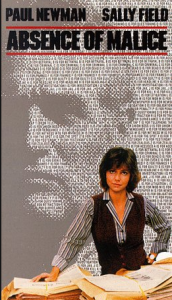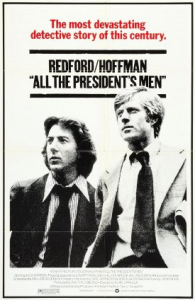The film Wag the Dog tells a dark yet witty story of the media controlling what society thinks due to political scandal. The title itself explains this, as we see in the opening credits of the film.
It is explained to the audience that while usually a dog wags its tail because it is smarter, but if the tail becomes smarter than the tail wags the dog. This is a metaphor for the media becoming smarter than the American people and controlling what they think, as we soon find out.
In class, we have seen many cases of the media manipulating the truth. For example, we were shown five photographs of hurricane Sandy that were actually manipulated, much to the surprise of the public. In addition to this, we’ve seen several situations in which word choice reveals media bias. However in Wag the Dog, the main characters do much more than simply choose biased words.
The main characters, an employee “spin doctor” on the president’s re-election campaign, and a famous movie producer are tasked to cover up a sexual assault scandal that the president is accused of. Along the way, they stage fake war scenes using actors and special effects, manipulate photos of captive US soldiers, and even hire an ex-soldier to act as a returning prisoner of war. They even stage a scene where the president appears to be in Albania (where the supposed war is occurring). These men do everything in their power to control what the media finds out, and in the long run what the public thinks.
While this may have been for the best in their opinions, it was without a doubt extremely unethical. These individuals may have believed that the president was the best choice for the next four years. In that case, it can be understood that they would do everything in their power to ensure his re-election. Regardless of their motives, lying to the public just to distract them is not what should have been done.
The Society of Professional Journalists’ code of ethics states, “seek the truth and report it”. While these government professionals were not in fact journalists, it should still be against anyone’s personal ethics to lie to the American public. In one scene, we see two of the individuals who helped fabricate the story get questioned. If more people, journalists in particular, investigated how true the story actually was, society might not have been lied to for as long as they were. If fabricated stories like this one go unpublished, it would lead to a world where no one would truly know if what the media says is true or false. It is up to journalists to seek the truth and let the world know it.
If I were in the same situation that this campaign “spin doctor” was in, I would not try to distract society with lies. Instead, I would address the problem head on and have the president give a formal apology. After all, if the president was indeed guilty of sexual assault, he is not a man I would want to be the leader of my country. I can be thankful however that to my knowledge that nothing like this has ever occurred, and am comforted by the fact that the Society of Professional Journalists has an official code of ethics for journalists and media personalities to look to for guidance.




